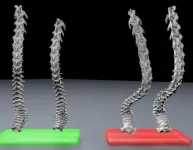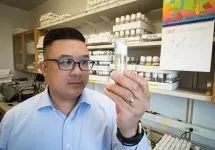(Press-News.org) Researchers from Queen Mary University of London and Zhengzhou University have developed a powerful therapeutic platform that uses a modified virus for the treatment of pancreatic cancer. By using the virus in combination with other drugs, the treatment significantly extended survival in preclinical models of pancreatic cancer.
Viruses that can selectively infect and destroy cancer cells, known as oncolytic viruses, are a promising new class of therapeutics for cancer. Through various mechanisms, oncolytic viruses kill cancer cells and elicit strong anti-tumour immune responses. However, current oncolytic virotherapy is unable to produce a long-term cure in patients, and the treatment has to be delivered directly into the tumour - a route that is not feasible for deeply embedded tumours, or tumours that have spread around the body.
The study, published today in the Journal for ImmunoTherapy of Cancer, describes a novel platform for the treatment of pancreatic cancer using an oncolytic Vaccinia virus that was modified to improve its safety, ability to spread within and between tumours and capacity to activate potent anti-tumour immune responses.
The research was supported by the Medical Research Council (MRC), Pancreatic Cancer Research Fund, Pancreatic Cancer UK, Nature Sciences Foundation of China and National Key R&D Program of China.
A re-engineered virus system
The study built upon previous work by the team (Ferguson et al, 2019; Ahmed et al, 2020), which developed a modified Vaccinia virus through the deletion of two viral genes. By combining treatment with the modified virus and a clinically available drug (PI3Kδ inhibitor) that prevented the destruction of the virus particles by the body's immune cells, the team created an effective treatment platform that was systemic (i.e. could travel through the body), specifically targeted pancreatic tumours and activated the immune system against the tumours in preclinical models.
In this new study, to improve the efficacy of the treatment platform, the team re-engineered the virus by modifying its genetic code to contain an additional, altered copy of a protein that is crucial to the ability of the virus to spread within and between tumours. The team also armed the virus with a protein called IL-21, which improved the virus' ability to trigger an immune response against the cancer.
Professor Yaohe Wang, from Barts Cancer Institute, Queen Mary University of London, who led the study, said: "This platform provides a powerful therapeutic to target multiple aspects of pancreatic cancer simultaneously through a convenient administration approach (intravenous injection), significantly improving the prospects of disease eradication and prevention of recurrence in pancreatic cancer patients. This platform is also suitable for treatment of other human tumour types."
Following administration of the novel oncolytic Vaccinia virus (named VVL-21) in preclinical models of pancreatic cancer, the virus successfully remodelled the suppressive tumour microenvironment to trigger potent anti-tumour immune responses. Importantly, treatment with VVL-21 also sensitised tumours to treatment with a type of immunotherapy known as an immune checkpoint inhibitor.
The combination of the three therapeutics - VVL-21, PI3Kδ inhibitor and the immune checkpoint inhibitor - created a powerful systemic therapeutic platform that significantly extended survival in a number of different, complex preclinical models of pancreatic cancer.
The deadliest of the common cancers
Pancreatic cancer is the 11th most common cancer in the UK; however, it has the lowest survival rate of all the common cancers, with less than 7% of patients surviving their cancer for five years or more. Pancreatic cancer is often diagnosed in the late stages of its development when the cancer is advanced or has spread to other parts of the body, making treatment difficult.
Chemotherapy and radiotherapy alone are relatively unsuccessful in treating pancreatic cancer and while surgery to remove the tumour offers the best chance of survival, more than 80% of patients ultimately die of the disease due to local recurrence and/or distant metastasis.
While immunotherapeutics such as immune checkpoint inhibition (ICI) have emerged as a promising new therapeutic approach, pancreatic cancer in particular is unresponsive to ICI monotherapy. The new virus developed in this study demonstrated a promising synergistic anti-tumour effect in combination with ICI immunotherapy.
Following additional funding from the MRC, the team are now hoping to conduct the necessary steps required to take the viral treatment system forward into phase I clinical trials to determine its potential within the clinic.
Dr Louisa Chard Dunmall, senior postdoctoral researcher at Barts Cancer Institute, Queen Mary University of London and joint first author of the study, said: "The current prognosis for patients with pancreatic cancer has not improved for many decades and so we urgently require new treatments that can improve long-term survival. Our platform provides an exciting new mechanism of attacking the tumour in these patients and we are grateful that we have received further funding from the MRC to support this project through pre-clinical toxicity testing and virus manufacture in the hope that we can take this platform forward into phase I clinical trials within the next 3 years."
INFORMATION:
Research paper: A systemically deliverable Vaccinia virus with increased capacity for intertumoral and intratumoral spread effectively treats pancreatic cancer. Giulia Marelli, Louisa S Chard Dunmall, Ming Yuan, Carmela Di Gioia, Jinxin Miao, Zhenguo Cheng, Zhongxian Zhang, Peng Liu, Jahangir Ahmed, Rathi Gangeswaran, Nicholas Lemoine, Yaohe Wang. Journal for ImmunoTherapy of Cancer. doi:10.1136/jitc-2020-001624.
Available here after embargo lifts: http://dx.doi.org/10.1136/jitc-2020-001624
A material that can be used in technologies such as solar power has been found to self-heal, a new study shows.
The findings - from the University of York - raise the prospect that it may be possible to engineer high-performance self-healing materials which could reduce costs and improve scalability, researchers say.
The substance, called antimony selenide (Sb2Se3), is a solar absorber material that can be used for turning light energy into electricity.
Professor Keith McKenna from the Department of Physics said: "The process by which this semi-conducting material self-heals is rather like how a salamander is able to re-grow limbs when one is severed. Antimony selenide repairs broken bonds created when it is cleaved by ...
The disproportionately high Covid-19 infection rates observed in Black Americans could be linked to their daily commuting patterns, according to a new study published today in the Journal of the Royal Society Interface.
The research found that increased exposure to other ethnic groups, for example as a result of an individual's job or use of public transport, can result in the emergence of an "infection gap" in the population, such as the abnormally high incidence of Covid-19 recorded in Black Americans.
In some areas of the US Covid-19 incidence in Black Americans can be up to three to five times higher than would be expected based on population data. Previous studies have highlighted socio-economic factors including lower income and poorer access to healthcare facilities ...
Chronic myeloid leukemia (CML) results from a degeneration of the hematopoietic stem cells (leukemia stem cells), thereby leading to the uncontrolled formation of specific white blood cells, the so-called granulocytes. Research work at the Department of Medical Oncology at the Inselspital, Bern University Hospital and the University of Bern focused therefore on identifying the signaling pathways and control mechanisms of the leukemia stem cell. A promising approach is provided by working with MPR, an anti-emetic medication commonly used to treat nausea and vomiting.
Specific blocking of leukemia stem cell proliferation with metoclopramide
The exact role of the surface molecule CD93 (cluster of differentiation 93) in controlling the ...
A multidisciplinary team of researchers at the University of Massachusetts Amherst's Institute for Applied Life Sciences (IALS) have developed a technique to replicate bone tissue complexity and bone remodeling processes. This breakthrough could help researchers further their study of bone biology and assist in improving development of drugs for osteoporosis.
Published in Science Advances, the researchers developed a new biomaterial they call demineralized bone paper. The team includes Jungwoo Lee, Yongkuk Park, Ryan Carpenter, chemical engineering; Eugene Cheong, ...
Our cells are filled with 'bones,' in a sense. Thin, flexible protein strands called actin filaments help support and move around the bulk of the cells of eukaryotes, which includes all plants and animals. Always on the go, actin filaments constantly grow, shrink, bind with other things, and branch off when cells move.
Supercomputer simulations have helped solve the mystery of how actin filaments polymerize, or chain together. This fundamental research could be applied to treatments to stop cancer spread, develop self-healing materials, and more.
"The major findings ...
A compound that extends lifespan in a tiny nematode worm slows bone loss in aging mice. That surprising result comes from a longitudinal and functional study of 700 aging mice at the Buck Institute, a project that provides a treasure trove of data for researchers aiming to develop therapeutics to slow aging and age-related diseases. The study is currently online in the Journal of Bone and Mineral Research Plus.
The project, which involved five Buck labs and took several years to complete, involved serially profiling the individual mice as they aged while testing several therapeutics that extended lifespan in simple model organisms ...
Black children have significantly higher rates of shellfish and fish allergies than white children, confirming that race plays an important role in how children are affected by food allergies, researchers at Rush University Medical Center have found. Results of the study were published in the February issue of the Journal of Allergy and Clinical Immunology: In Practice.
"Food allergy is a common condition in the U.S., and we know from our previous research that there are important differences between African-American and white children with food allergy, but there is so much we need to know to be able to help our patients from minority groups," said Dr. Mahboobeh Mahdavinia, who is lead author of the ...
A research team from the CHUM Research Centre (CRCHUM) has shown that women who have had serious complications during pregnancy are twice as likely to die up to three decades later.
Serious conditions such as stroke, cardiac complications, acute kidney failure and pre-eclampsia affect just under 5 % of women during pregnancy and childbirth.
In a study published in Obstetrics & Gynecology, CRCHUM researcher Dr. Nathalie Auger and postdoctoral fellow Ugochinyere Vivian Ukah examined the long-term mortality risks of women with these types of pregnancy complications by analyzing more than 1.2 million records of women who gave birth in Quebec between 1989 and 2016.
Their findings? Compared to women who had no serious pregnancy complications, women ...
In 2012, four-year-old Bertrand Might became the first-ever patient diagnosed with a rare genetic disorder called N-glycanase (NGLY1) deficiency. The discovery of this condition and Bertrand's diagnosis allowed doctors to look for other children with the same genetic defect. Since then, more than 60 additional patients have been found. The disease affects every system of the body and is characterized by low muscle tone, seizures, developmental delays, and an inability to produce tears.
Sadly, Bertrand passed away in October at the age of 12. Although his life was cut short, his legacy will benefit children around the world. Through ...
A recent study of drugged driving, by a team of University of Cincinnati researchers, shows that a sizable percentage of individuals reported the use of marijuana and other illicit drugs while operating behind the wheel.
"We need to focus our efforts on drugged driving, in addition to drunk driving, because drugged driving causes such a high level of fatalities, says Andrew Yockey, a doctoral student in UC's College of Education, Criminal Justice and Human Services and researcher at the UC Center for Prevention Science.
Yockey is lead author on the study ...


